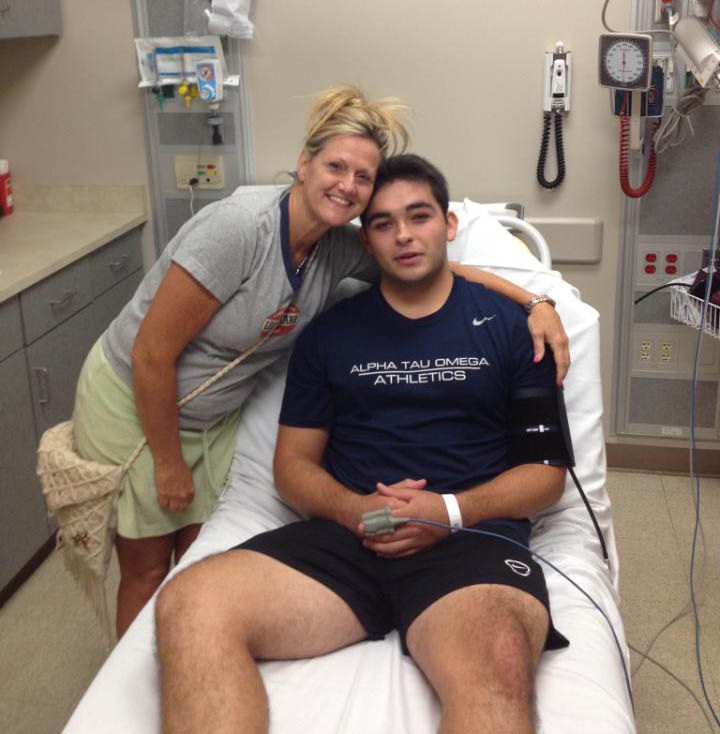
Austin Dick locked onto his target, a football thrown over the middle and dropping toward him.
The Oklahoma State management senior said the details are all secondhand because he has no memory of the event.
As he moved up on the ball from his deep safety position, he didn’t see the receiver or his teammate on a collision course with him.
The lights went out. Violently.
“All I remember is them hiking the ball, and then I remember waking up with four or five (EMTs) surrounding me, and I had no idea what happened,” Dick said. “They were asking me if I knew what day it was, or where I was at, and I couldn’t answer any of those questions.”
The game stopped when Dick’s face smashed into his teammate’s ear. The collision knocked him to the ground as his concussed brain settled in his skull. When he came to, he said nothing was as it seemed.
“I laid there for a while, called my mom,” Dick said. “I was still really out of it not knowing what was going on. I remember looking over at my friend who I hit and his ear is gushing blood, and I’m like, ‘How’d you get hurt?’”
Dick said he was able to walk to a car for a ride to the emergency room and recovered in just over a week. He said he returned to the field a month later.
University of Tulsa’s director of athletic training said intramural concussions are a genuine concern, namely with when players can return to the field. Ron Walker, also a clinical professor at TU, said when testing for concussions, athletic trainers will use cognitive tests compared with predetermined base scores for a given player.
If a player scores lower after a hit to the head or shows obvious signs of a concussion, he or she is pulled from competition. A player is cleared to return only when he or she achieves the same cognitive marks as before, Walker said. He said the criteria are important not only to show progress, but also to keep players in check.
“Waiting for a participant to self-report is like asking a drunk if they want another beer,” Walker said.
He said it’s the time immediately after a concussion when the risk is greatest for serious injury, often when someone has the common symptom of a headache.
“If someone sustains a second concussion while they still have that symptom, they’re at a significant risk for even a fatal injury; it’s called second-impact syndrome,” Walker said. “When there’s no athletic trainer, it’s common sense recognition of that being a possibility.”
OSU’s assistant director of recreational programs said the department implemented a concussion policy in January, and two students have already gone through the protocol for suspected concussions.
Jason Linsenmeyer said supervisors are trained to spot concussions and given specific protocols for when players can return to playing sports or attending classes.
“If there’s a suspected concussion based on these signs my supervisors have been trained on, they’re going to pull the individual out,” Linsenmeyer said. “Any of those individuals that are pulled out for a potential concussion have to go seek medical attention before they’ll be allowed to play intramural or club sports again.”
Linsenmeyer said supervisors receive training on concussion protocols, and officials have a card listing signs and symptoms of concussions on their person. But he also said those watching aren’t medical staff.
“It’s just our staff as far as officials and supervisors; sometimes our graduate students go out there, but none of them are athletic trainers, none of them are any of the advanced medical training certifications,” Linsenmeyer said.
Although tracking concussions is a good start for any intramural department, it depends on who’s monitoring players, Walker said.
He said although referees or supervisors can act as monitors, they’re focused on the rules and the fair play of a game, not specifically any signs of a concussion. Ideally, an athletic trainer can observe participants because otherwise some less-obvious concussions might be missed.
“From an injury surveillance standpoint, yeah, it’s certainly going to be hard to track,” Walker said. “When they have an incident and there’s a report filed, I would think that if the reports reflected that participants have concussions, I would think those would only be the most severe cases, which would be in the minority.”
Linsenmeyer said because the undergraduate athletic training program was moved to an OSU-Tulsa graduate program, there isn’t a viable way to have medical staff observe.
“There’s really no avenues here to get athletic trainers,” Linsenmeyer said. “Obviously, those are expensive. We have lots of events; we have 50 plus events that we offer every year.
“Trying to staff an athletic trainer or someone who’s got advanced medical certifications, that budget would go out the roof just for basketball, same thing for flag football. … Trying to provide that would be a nightmare as far as budget concerns. We just don’t have that available. ”
Walker said even if officials monitor for concussions, they should be trained enough to provide the rising standard of care for intramural sports.
“There’s absolutely no reason for intramural departments across the country to not accept (concussion training) as a standard and require that for their intramural officials and game managers,” Walker said.